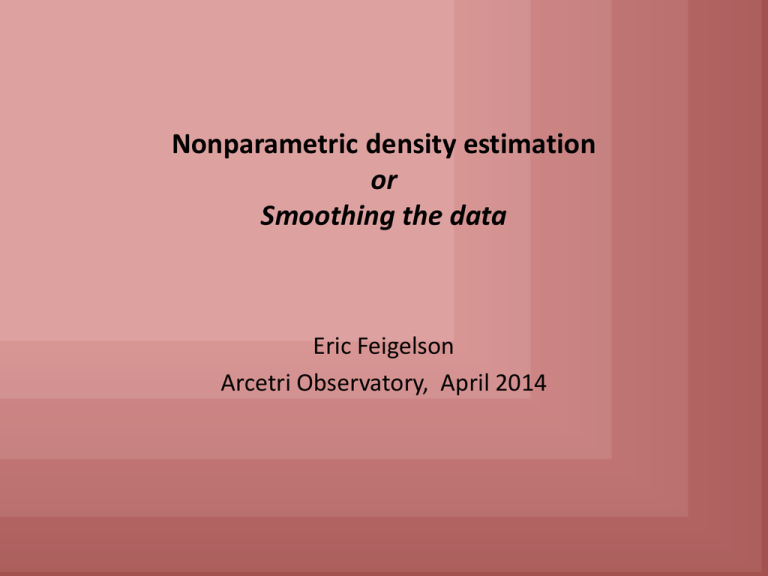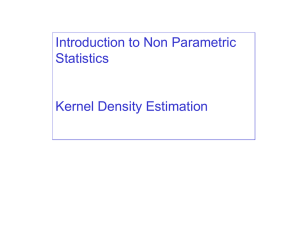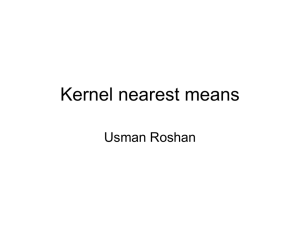3_Density estimation
advertisement

Nonparametric density estimation or Smoothing the data Eric Feigelson Arcetri Observatory, April 2014 Why density estimation? The goal of density estimation is to estimate the unknown probability density function of a random variable from a set of observations. In more familiar language, density estimation smoothes collections of individual measurements into a continuous distribution, replacing dots on a scatterplot by a smooth estimator curve or surface. When the parametric form of the distribution is known (e.g., from astrophysical theory) or assumed (e.g., a heuristic power law model), then the estimation of model parameters is the subject of regression (MSMA Chpt. 7). Here we make no assumption of the parametric form and are thus involved in nonparametric density estimation. Astronomical applications • Galaxies in a rich cluster underlying distribution of baryons • Lensing of background galaxies underlying distribution of Dark Matter • Photons in a Chandra X-ray image underlying X-ray sky • Cluster stars in a Hertzsprung-Russell diagram stellar evolution isochrone • X-ray light curve of a gamma ray burst afterglow temporal behavior of a relativistic afterglow • Galaxy halo star streams cannibalism of satellite dwarf galaxy Problems with the histogram • • • • • Discontinuities between bins are not present in the underlying population No mathematical guidance for choosing origin, x0 No mathematical guidance for binning (grouping) method: equal spacing, equal # points, etc. No mathematical guidance for choosing the `center’ of a bin Difficult to visualize multivariate histograms `In terms of various mathematical descriptions of accuracy, the histogram can be quite substantially improved upon'. (Silverman 1992) `The examination of both undersmoothed and oversmoothed histograms should be routine.’ (Scott 1992) Histograms are useful for exploratory visualization of univariate data, but are not recommended for statistical analysis. Fit models to the original data points and (cumulative) e.d.f.’s, not the (differential) histogram, unless the data are intrinsically grouped Kernel density estimation The most common nonparametric density estimation technique convolves discrete data with a normalized kernel function to obtain a continuous estimator: A kernel must integrate to unity over – < x < , and must be symmetric, K(u) = K(-u) for all u. If K(u) is a kernel, then a scaled K*(u) = lK(lu) is also a kernel. A normal (Gaussian) kernel a good choice, although theorems show that the minimum variance is given by the Epanechnikov kernel (inverted parabola). The uniform kernel (`boxcar’, `Heaviside function’) give substantially higher variance. http://en.wikipedia.org/wiki/Kernel_density_estimation http://en.wikipedia.org/wiki/Kernel_(statistics) The choice of bandwidth is tricky! A narrow bandwidth follows the data closely (small bias) but has high noise (large variance). A wide bandwidth misses detailed structure (high bias) but has low noise (small variance). Statisticians often choose to minimize the L2 risk function, the mean integrated square error (MISE), MISE = Bias2 + Variance ~ c1h4 + c2h-1 (The constant c1 depends on the integral of the second derivative of the true p.d.f. ) The `asymptotic mean integrated square error’ (AMISE) based on a 2nd-order expansion of the MISE is often used. KDE: Choice of bandwidth The choice of bandwidth h is more important than the choice of kernel function. Silverman’s `rule of thumb’ that minimizes the MISE for simple distributions is where A is the minimum of the standard deviation s and the interquartile range IQR/1.34. More generally, statisticians choose kernel bandwidths using cross-validation. Important theorems written in the 1980s show that maximum likelihood bandwidths can be estimated from resamples of the dataset. One method is leave-on-out samples with (n-1) points, and the likelihood is Alternatives include the `least squares cross-validation’ estimator, and the `generalized cross-validation’ (GCV) related to the Akaike/Bayesian Information Criteria. Example of normal kernel smoothing h=0.05 h=0.337 min MISE N(0,1) true density h=2.0 data points (rug plot) Rarely recognized by astronomers … Confidence bands around the kernel density estimator can be obtained: • For large samples and simple p.d.f. behaviors, confidence intervals for normal KDEs can be obtained from asymptotic normality (i.e. the Central Limit Theorem) • For small or large samples and nearly-any p.d.f. behviors, confidence intervals for any KDE can be estimated from bootstrap resamples. Adaptive smoothing Standard kernel density estimation (KDE) assumes that the statistical properties of the underlying population is stationary (the same at all values of x) so that a constant bandwidth h can be used. However, in many astronomical datatsets, the behavior is nonstationary: sources appear in images; events appear in time series; detailed structures are evident where data points are densely sampled; and so forth. Astronomers thus often seek adaptive smoothing techniques that give locally (rather than globally) optimal estimation of the population from the data. Unfortunately, modern statistics does not provide a unique optimal procedure for adaptive smoothing, and techniques developed within astronomy have not been evaluated. This is an area ripe for improved astrostatistical research. Some adaptive smoothing techniques • Scale KDE bandwidth by the inverse square-root of the local p.d.f. estimate Abramson Ann. Stat. 1982 has minimal MSE at x=0. Zero bias? • Silverman’s adaptive kernel estimator (MSMA, eqns 6.13=6.15) • Kth-nearest neighbor (k-NN) estimators: the p.d.f. estimator at each data points xi is the inverse of the distance to the kth-NN around that point. (Related to KDE with uniform kernel) Kernel regression A regression approach to smoothing bivariate or multivariate data … E(Y | x) = f(x) Read “the expected population value of the response variable Y given a chosen value of x is a specified function of x”. A reasonable estimation approach with a limited data set is to find the mean value of Y in a window around x, [x-h]/, x+h/2) with h chosen to balance bias and variance. A more effective way might include more distant values of x downweighted by some kernel p.d.f. function such as N(0,h2). This called kernel regression, a type of local regression. The `best fit’ might be obtained by locally weighted least squares or maximum likelihood. Two common nonparametric regressions Nadaraya-Watson estimator Local polynomial smoother (LOWESS, LOESS, Friedman’s supersmoother) Spline regression The function f(x) can be any (non)linear function but is often chosen to be a polynomial. If the polynomials are connected together at a series of knots to give a smooth curve, the result is called a spline. Kass 2008 Variants that avoid high correlation among the fitted parameters are B-splines and natural splines. The challenge of spline knot selection 7 knots chosen by user 5 knots chosen by R 15 knots chosen by R Kass 2008 Comment for astronomers Due to unfamiliarity with kernel density estimation and nonparametric regressions, astronomers too often fit data with heuristic simple functions (e.g. linear, linear with threshold, power law, ….). Unless scientific reasons are present for such functions, it is often wiser to let the data speak for themselves, estimating a smooth distribution from data points nonparametrically. A variety of often-effective techniques are available for this. Well-established methods like KDE and NW estimator have asymptotic confidence bands. For all methods, confidence bands can be estimated by bootstrap methods within the `window’ determined by the (local/global) bandwidth. Astronomers thus do not have to sacrifice `error analysis’ using nonparametric regression techniques.







